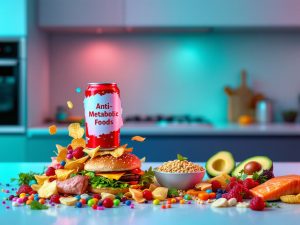Living with diabetes doesn’t mean you have to give up your favorite carb-heavy meals. With the right strategies, you can enjoy your food while keeping your blood sugar levels stable. This guide shares practical, science-backed tips to help you prevent blood sugar spikes and manage your diabetes effectively.
Before or During the Meal
Eat Fiber First
Starting your meal with fiber-rich vegetables like spinach, broccoli, okra, or a fresh salad can significantly reduce blood sugar spikes. Fiber slows down digestion and carbohydrate absorption, creating a buffer that helps stabilize glucose levels.
- Tip: Try a small bowl of leafy greens or steamed veggies as a starter before your main course.
Pair Carbs with Protein and Healthy Fats
Including protein and healthy fats in your meal helps slow gastric emptying, which means carbohydrates are absorbed more gradually. Foods like eggs, chicken, paneer, curd, or nuts are excellent choices to balance your plate.
- Try This: Add grilled chicken, a dollop of curd, or a handful of almonds to your meal for a nutrient boost.
Choose Low Glycemic Index (GI) Carbs
Not all carbs are created equal. High-GI carbs like white rice, white bread, or potatoes can cause rapid blood sugar spikes. Opt for low-GI alternatives that release glucose more slowly:
- Brown rice
- Quinoa
- Whole wheat roti
- Legumes and dals
- Sweet potatoes (in moderation)
- Pro Tip: Experiment with low-GI grains to find tasty options that suit your taste and blood sugar goals.
Control Portion Sizes
Even healthy carbs can raise blood sugar if consumed in large amounts. Use the plate method to keep portions in check:
- ½ plate: Non-starchy vegetables (e.g., greens, cauliflower, zucchini)
- ¼ plate: Lean protein (e.g., fish, tofu, lentils)
- ¼ plate: Low-GI carbs (e.g., quinoa, whole wheat pasta)
Using measuring cups or a smaller plate can also help you avoid overloading on carbs.
Use Vinegar or Lemon Juice
Adding a tablespoon of apple cider vinegar or a squeeze of lemon juice to your meal may improve insulin sensitivity and reduce post-meal blood sugar spikes by slowing carbohydrate breakdown.
- How to Use: Mix a tablespoon of apple cider vinegar in a glass of water before eating, or drizzle lemon juice over your salad or veggies.
After the Meal
Take a Light Post-Meal Walk
One of the most effective ways to lower blood sugar is to move your body. A 10–20-minute walk after a meal can significantly reduce postprandial glucose levels by helping your muscles use excess sugar.
- Make It Fun: Stroll with a friend, listen to music, or take your dog for a walk to make it an enjoyable habit.
Stay Hydrated
Drinking enough water throughout the day supports your kidneys in flushing out excess glucose through urine. Proper hydration also promotes overall metabolic health.
- Goal: Aim for 8–10 glasses of water daily, and sip water during and after meals to aid digestion.
Additional Tips for Blood Sugar Control
Stick to Consistent Meal Timing
Irregular eating patterns or large gaps between meals can lead to unstable blood sugar levels. Aim to eat at regular intervals to maintain steady glucose levels throughout the day.
- Try This: Plan for three balanced meals with 1–2 small snacks, depending on your needs and your doctor’s advice.
Monitor Your Blood Sugar
Every body responds differently to foods, so tracking your blood sugar with a glucometer is key. Test before and after meals to see how specific foods affect you, and use this data to fine-tune your diet.
- Pro Tip: Keep a food and blood sugar log to identify patterns and make informed choices.
Follow Your Medication Plan
If you’re on medications like metformin or insulin, take them as prescribed. Never adjust your dosage without consulting your doctor, especially if you’re making significant changes to your diet or activity levels.
- Important: Always discuss dietary changes with your healthcare provider to ensure your medication plan aligns with your new habits.
Glycemic Index Comparison
Glycemic Index of Common Foods
This chart compares the glycemic index of common carbohydrate sources, helping you choose lower-GI options to minimize blood sugar spikes.
Key Notes Section
Key Takeaways for Stable Blood Sugar
- Prioritize Fiber: Start meals with vegetables to slow carb absorption.
- Balance Your Plate: Combine carbs with protein and healthy fats.
- Choose Wisely: Opt for low-GI carbs like quinoa or whole wheat roti.
- Stay Active: A short walk after meals can work wonders.
- Monitor and Adjust: Use a glucometer to track and refine your approach.
Frequently Asked Questions
Can I eat carbs if I have diabetes?
Yes, you can enjoy carbs in moderation by choosing low-GI options and pairing them with fiber, protein, and healthy fats to minimize blood sugar spikes.
How does vinegar help with blood sugar?
Apple cider vinegar may improve insulin sensitivity and slow carbohydrate digestion, reducing post-meal glucose spikes. Mix 1 tablespoon in water before meals.
Why is post-meal walking effective?
Walking after meals helps your muscles use glucose for energy, lowering blood sugar levels. Even a 10–20-minute walk can make a significant difference.
Conclusion
Preventing blood sugar spikes after a carbohydrate-heavy meal is all about balance and strategy. By starting with fiber, choosing low-GI carbs, controlling portions, and incorporating post-meal movement, you can enjoy your meals while keeping your diabetes in check. Always work closely with your healthcare team to tailor these tips to your unique needs.
Take Action: Start with one or two of these strategies this week, track your progress with a glucometer, and share your results with your doctor or on social platforms like X to inspire others!




